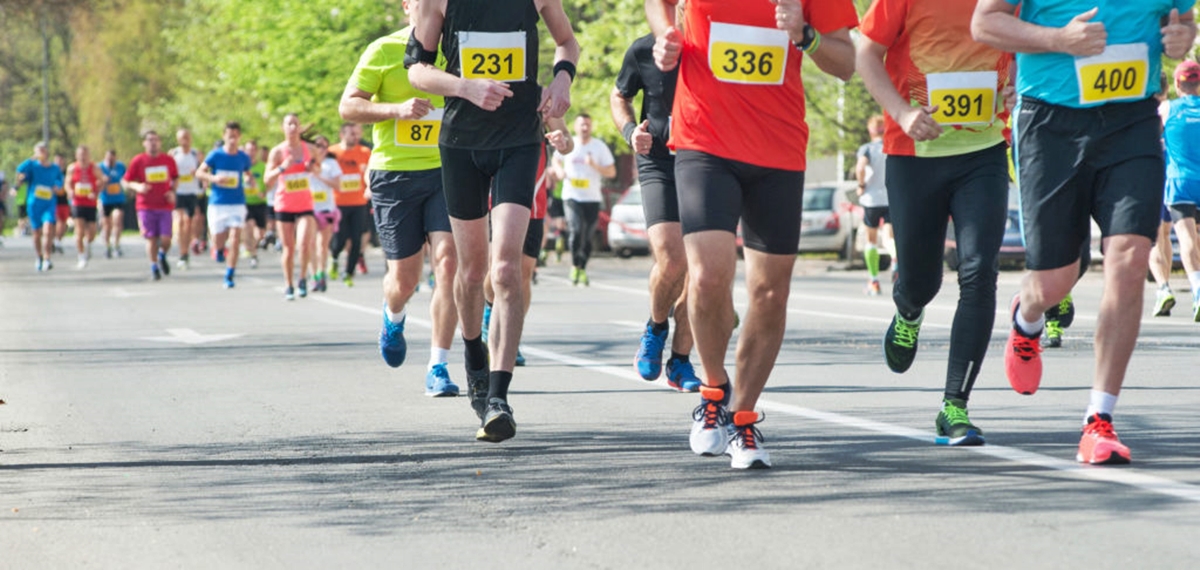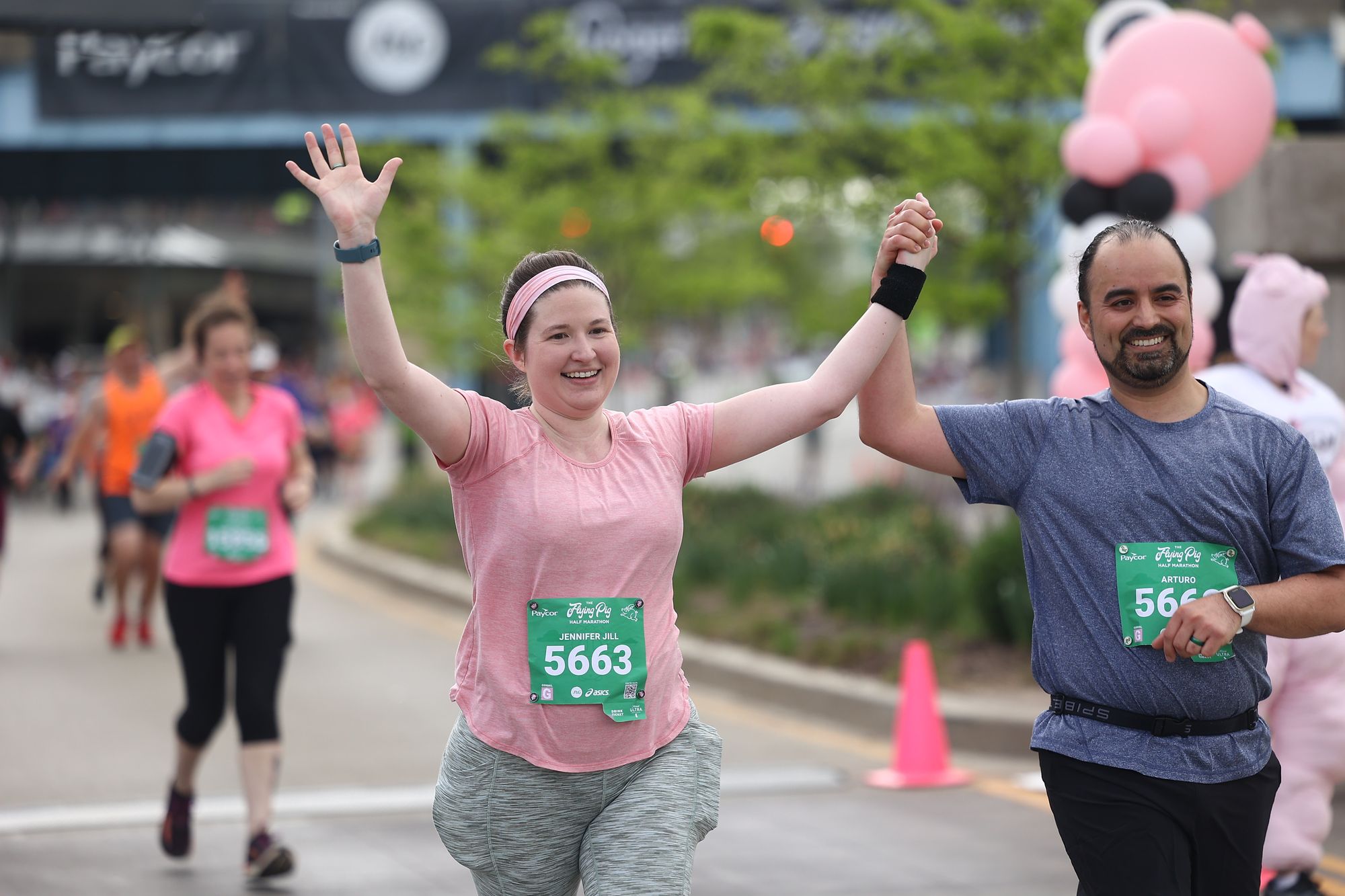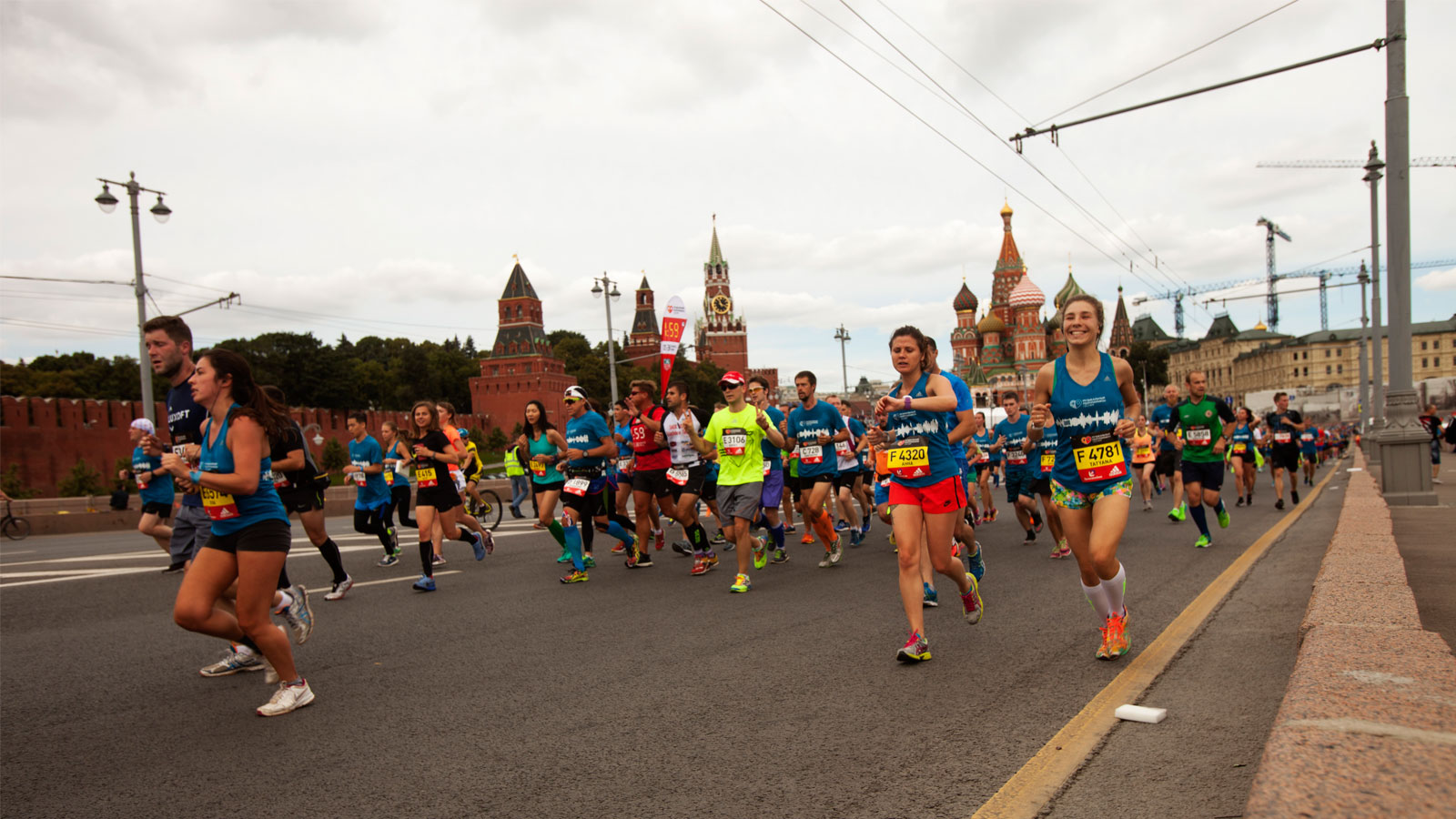Home>Misc>Featured>How Long Does A Half Marathon Take To Run


Featured
How Long Does A Half Marathon Take To Run
Modified: January 22, 2024
Discover how long it takes to complete a half marathon with our featured guide. Find out the average time and tips to improve your race performance.
Introduction
A half marathon is a challenging and rewarding distance for runners of all levels. It offers a unique balance between endurance and speed, pushing athletes to their limits. Whether you are a competitive runner aiming for a personal best or a recreational runner looking to complete the distance, understanding the factors that affect half marathon times is crucial.
Completing a half marathon requires dedication, training, and a solid understanding of your personal strengths and abilities. In this article, we will explore the various factors that can influence how long it takes to run a half marathon. From training and experience to course terrain and conditions, each aspect plays a significant role in determining your race time.
It’s important to note that every individual is unique, and there is no one-size-fits-all answer to how long a half marathon should take. Factors such as age, gender, fitness level, and personal goals all contribute to the overall performance on race day. Understanding these factors can help you set realistic expectations and tailor your training accordingly.
Whether you’re a seasoned runner or a beginner, this article will provide valuable insights and strategies to help you improve your half marathon times. By implementing proper training techniques, employing effective pacing strategies, and maintaining a healthy and balanced lifestyle, you can propel yourself towards achieving your personal best.
So, grab your running shoes, prepare your mind and body, and let’s dive into the world of half marathon training and racing to uncover the secrets of running your best half marathon.
Factors Affecting Half Marathon Times
When it comes to running a half marathon, there are several key factors that can influence your race time. Understanding these factors will not only help you set realistic goals but also allow you to make targeted training adjustments to improve your performance. Let’s explore some of the most significant factors that affect half marathon times:
- Training: A well-structured training program is essential for success in a half marathon. The amount of time dedicated to training, the quality of workouts, and the consistency of training sessions all play a role in determining race performance. Consistent training allows your body to adapt to the demands of the race and build the necessary endurance to sustain your pace.
- Experience and Fitness Level: Previous running experience and overall fitness level can greatly impact half marathon times. A more experienced runner may have a better understanding of pacing, hydration strategies, and mental preparedness, giving them an advantage over a novice runner. Additionally, a higher fitness level translates to better cardiovascular fitness, muscular strength, and overall endurance.
- Course Terrain and Conditions: The terrain and conditions of the racecourse can significantly affect race times. A flat and fast course can potentially lead to faster times compared to a hilly or challenging terrain. Weather conditions, such as heat, humidity, and wind, can also impact performance. It’s important to assess the course profile and consider the potential impact of external factors when setting race goals.
- Pacing Strategy: Developing an effective pacing strategy is crucial in a half marathon. Starting too fast can lead to early fatigue and a decline in performance later in the race. On the other hand, starting too slow may limit your ability to maximize your potential. Finding the right balance and maintaining a consistent pace throughout the race is key to achieving your desired time.
Incorporating these factors into your training and race preparation will increase your chances of running a successful half marathon. However, it’s important to remember that each individual is unique, and these factors can affect each person differently. It’s essential to find what works best for you through trial and error and make adjustments accordingly.
Training
Training plays a crucial role in preparing your body for the demands of a half marathon. A well-designed training plan will help you build endurance, improve your running efficiency, and increase your overall speed. Here are some key elements to consider when training for a half marathon:
- Consistency: Consistency is key when it comes to training for a half marathon. Regularly scheduled runs, cross-training sessions, and rest days are vital to allow your body to adapt and recover. Aim to establish a training routine that suits your schedule and commit to it.
- Long Runs: Long runs are an essential component of half marathon training. These runs gradually increase in distance and simulate the demands of the race. They help build your endurance, both physically and mentally, and allow you to practice your pacing strategy.
- Speed Workouts: Incorporating speed workouts into your training plan can help improve your overall race pace. These workouts include intervals, tempo runs, and fartlek sessions designed to challenge your body and improve your running efficiency.
- Strength Training: Don’t overlook the importance of strength training. Incorporating exercises that target your lower body, core, and upper body can help improve your running form, prevent injuries, and increase your overall strength and power.
- Rest and Recovery: Rest and recovery days are just as important as training days. They allow your body to repair and rebuild, reducing the risk of overtraining and injury. Listen to your body and incorporate rest days and recovery activities, such as stretching and foam rolling, into your training plan.
- Mental Preparation: Half marathons require mental toughness. Incorporate mental preparation techniques into your training, such as visualization, positive affirmations, and goal-setting. These techniques can help you stay focused and motivated during the challenging moments of the race.
Remember, every individual is unique, and what works for one person may not work for another. It’s important to listen to your body, be flexible with your training plan, and make adjustments as needed. Working with a running coach or joining a running group can also provide guidance, support, and accountability throughout your training journey.
Experience and Fitness Level
Your experience and fitness level play a significant role in determining your half marathon performance. Both factors can impact your race preparation, pacing, and overall endurance. Let’s explore how experience and fitness level can affect your half marathon times:
- Experience: Previous running experience can give you valuable insight into pacing, race day strategies, and mental preparedness. Experienced runners tend to have a better understanding of their body’s capabilities and limitations, allowing them to make informed decisions during the race. They may also have experience in training for long-distance events, which can positively influence their half marathon performance.
- Fitness Level: Your overall fitness level, including cardiovascular fitness and muscular strength, can significantly impact your half marathon times. A higher fitness level generally results in higher levels of aerobic endurance and energy efficiency. Regular cardiovascular exercise, such as running, swimming, or cycling, helps improve your body’s ability to transport oxygen and fuel to your muscles, enhancing your endurance during the race.
- Training Background: If you have a background in other endurance sports or activities, such as cycling or swimming, it can help improve your fitness level and overall endurance. Cross-training activities can complement your running training, strengthen different muscle groups, and prevent overuse injuries.
- Progression: Your progression as a runner, including the consistency and intensity of your training, can also impact your half marathon times. The more consistent and structured your training, the more you can improve your fitness level and running performance. Gradually increasing your training volume and intensity over time allows your body to adapt and build the necessary endurance for the race.
- Mental Toughness: Experience in previous races can contribute to mental toughness, which is crucial during the challenging moments of a half marathon. Knowing that you’ve successfully completed similar distances before can boost your confidence and help you push through any discomfort or fatigue you may encounter during the race.
It’s important to remember that experience and fitness level are not limiting factors. Regardless of your starting point, with proper training, dedication, and a positive mindset, you can improve your half marathon performance over time. Embrace the journey and strive to constantly challenge and surpass your previous accomplishments.
Course Terrain and Conditions
The terrain and conditions of the racecourse have a significant impact on your half marathon times. It’s crucial to consider these factors when setting your race goals and developing your pacing strategy. Here are some key considerations regarding course terrain and conditions:
- Course Elevation: The elevation profile of the racecourse can greatly affect your race performance. A flat course typically allows for faster times, as there are fewer uphill segments to slow you down. In contrast, a hilly course with steep inclines may slow your pace and require more effort. Understanding the course elevation will help you tailor your training and pacing strategy accordingly.
- Terrain Surface: The type of surface you run on can also impact your race times. A smooth and even pavement allows for a more efficient stride and faster turnover. On the other hand, rough or uneven terrain, such as trails or gravel paths, may require more energy and slower speeds. Familiarize yourself with the racecourse surface to adjust your training and prepare for the specific conditions.
- Weather Conditions: Weather conditions on race day can greatly impact your performance. Factors such as temperature, humidity, wind, and precipitation can make a significant difference in your overall comfort and running efficiency. Hot and humid conditions may increase fatigue and hydration requirements, while strong winds can create challenges in maintaining a steady pace. Stay informed about the weather forecast and make adjustments to your race strategy accordingly.
- Crowd Support: The presence of a supportive crowd can make a positive impact on your performance. The energy and encouragement from spectators can provide motivation and a mental boost during the race. Courses with enthusiastic crowd support can create a more engaging and exciting atmosphere, potentially leading to improved times.
- Aid Stations and Course Layout: The location and frequency of aid stations along the course, as well as the overall course layout, can influence your race strategy. Knowing the placement of hydration and fuel stations allows you to plan your nutrition and hydration strategy. Understanding any sharp turns or challenging sections of the course can help you mentally prepare and adjust your pace as needed.
Each racecourse has its unique characteristics, and it’s important to familiarize yourself with the course terrain and conditions before race day. This will allow you to make informed decisions and adapt your strategy accordingly. Prepare both physically and mentally, and be ready to embrace the challenges and opportunities that the course presents.
Pacing Strategy
Developing a smart pacing strategy is essential for a successful half marathon. Finding the right balance between starting too fast and finishing strong can have a significant impact on your race time. Here are some key considerations when planning your pacing strategy:
- Know Your Target Pace: Determine your target pace for the race based on your fitness level, training progress, and race goals. This pace should be challenging yet sustainable for the entire distance. Aiming for a consistent pace throughout the race can help you avoid burnout and maintain a steady rhythm.
- Start Conservatively: It’s tempting to start the race at a fast pace due to adrenaline and excitement. However, starting too fast can lead to early fatigue and make it difficult to maintain your target pace. Begin the race slightly slower than your goal pace and gradually build into it as you settle into a comfortable rhythm.
- Negative Splits: Many experienced runners aim for negative splits, which means running the second half of the race faster than the first half. This strategy allows you to conserve energy in the early stages and finish strong. Practice this strategy during your training runs to familiarize yourself with the feeling of gradually picking up your pace as the race progresses.
- Maintain a Consistent Effort: Focus on maintaining a consistent effort throughout the race, even if your pace varies slightly due to course terrain or weather conditions. This helps ensure that you don’t expend excessive energy early on, which can lead to fatigue later in the race.
- Use Mile Markers and Split Times: Utilize mile markers and your planned split times to monitor your progress during the race. This allows you to make real-time adjustments to your pace if necessary. However, avoid becoming fixated on every second or mile and instead focus on running by feel and staying in control.
- Stay Mentally Strong: Pacing requires mental discipline and focus. Be prepared for moments when the race becomes challenging, and negative thoughts start to creep in. Stay positive, remind yourself of your training and preparation, and break the race into smaller segments or milestones to keep your mind engaged.
Remember, finding the right pace for you may require practice and adjustments. It’s essential to experiment with different pacing strategies during your training runs and shorter races to determine what works best for you. Trust your training, trust your instincts, and stay committed to executing your pacing plan on race day.
Average Half Marathon Times
Half marathon times can vary greatly depending on various factors such as experience, fitness level, age, and gender. It’s important to note that average times can serve as a benchmark, but individual performance can deviate significantly. Let’s explore the average half marathon times for different groups:
- Elite Runners: Elite runners are typically the fastest and most experienced athletes in the field. For male elite runners, the average half marathon time ranges between 1:00:00 and 1:05:00, while female elite runners average between 1:10:00 and 1:15:00. These times demonstrate the exceptional speed and endurance of top-level runners.
- Recreational Runners: Recreational runners include a wide range of individuals who participate in half marathons for personal achievement and enjoyment. For male recreational runners, average times range between 1:30:00 and 2:00:00, while female recreational runners average between 1:45:00 and 2:30:00. These times represent the broad spectrum of fitness levels and running abilities within the recreational running community.
- Age and Gender Differences: Half marathon times can also vary based on age and gender. It’s common for younger runners, typically in their 20s and 30s, to have faster average times compared to older age groups. Additionally, men tend to have slightly faster average times compared to women. However, these differences diminish when considering factors such as training, experience, and overall fitness level.
It’s important to remember that these average times should not discourage or limit anyone’s personal goals. Every runner’s journey is unique, and improvements can be made through consistent training and dedication. Regardless of where you fall within the average range, the primary focus should be on personal progress and the joy of participating in the event.
Finally, it’s worth noting that half marathon courses can vary in difficulty, with factors such as elevation changes, weather conditions, and terrain affecting overall times. Comparing times from different races can be challenging due to these variations, so it’s crucial to consider the specific conditions of each race when evaluating performance.
Elite Runners
Elite runners are a select group of highly trained athletes who consistently achieve remarkable performances in half marathons and other distance races. These individuals dedicate their lives to mastering their craft and pushing the limits of human endurance. Let’s delve into the average half marathon times for elite runners and gain insight into their exceptional abilities:
For male elite runners, average half marathon times fall within the impressive range of 1:00:00 to 1:05:00. These athletes maintain an incredible pace, consistently running under 5 minutes per mile, showcasing their superior speed, aerobic capacity, and ability to sustain an intense effort throughout the race.
Female elite runners also display incredible talent and endurance, with average half marathon times ranging between 1:10:00 and 1:15:00. These remarkable athletes consistently maintain a pace under 6 minutes per mile, demonstrating their strength, determination, and exceptional running form.
The average times achieved by elite runners highlight the culmination of years of dedicated training and a deep understanding of running mechanics, pacing strategies, and race-day tactics. They possess a unique blend of physical capabilities, mental fortitude, and race experience that sets them apart from the majority of recreational runners.
In addition to their impressive times, elite runners often compete at the highest levels of the sport, including national and international competitions. They may regularly participate in elite racing circuits and represent their countries in prestigious events such as the Olympics or World Championships. Their performances inspire and captivate running enthusiasts around the world.
It’s important to remember that elite runners’ times showcase the upper echelons of the sport and shouldn’t be used as direct comparisons for recreational runners. They have dedicated their lives to training and have access to professional coaches, sports nutritionists, and state-of-the-art training facilities. The focus for recreational runners should be on personal progress, setting and achieving individual goals, and embracing the joy of running.
Despite the exceptional abilities of elite runners, they also face their own challenges and setbacks. Overcoming injuries, maintaining motivation, and continually striving for improvement are all part of their journey. They serve as a reminder that even at the highest level of athletic performance, perseverance and resilience are key.
Watching elite runners in action, whether in person or through televised races, can be both inspiring and motivating. Their dedication and passion for the sport can fuel your own running aspirations and remind you of the limitless potential within each and every runner.
Recreational Runners
Recreational runners encompass a diverse group of individuals who participate in half marathons for personal achievement, fitness, and the joy of running. They range from beginners to seasoned runners, each with their own unique goals and motivations. Let’s explore the average half marathon times for recreational runners and gain insight into their achievements:
For male recreational runners, average half marathon times fall within the range of 1:30:00 to 2:00:00. These individuals put in considerable effort and training to complete the distance, demonstrating their dedication to improving their fitness and challenging themselves both physically and mentally.
Female recreational runners have slightly higher average half marathon times, ranging between 1:45:00 to 2:30:00. These women consistently work hard to train and prepare for the race, showcasing their determination to conquer the distance and achieve their personal goals.
It’s important to note that recreational runners come from varied backgrounds and fitness levels. Some may be newer to running and are focused on completing their first half marathon and enjoying the experience. Others may be more experienced and aim to improve their personal best times with each race.
Recreational runners often face the challenge of juggling their training with other responsibilities such as work, family, and social commitments. Despite these time constraints, they find ways to prioritize their running and carve out the necessary training hours to prepare for the half marathon. Their dedication and commitment serve as a testament to their passion for the sport.
Each runner’s journey is unique, and what matters most is personal progress and growth. Seeing improvements in training times, increasing endurance, or achieving a personal best in a race can be incredibly satisfying and motivating for recreational runners.
Participating in half marathons provides recreational runners with a sense of accomplishment and a platform to challenge themselves beyond their comfort zones. The supportive and inclusive nature of the running community often leads to friendships, shared experiences, and a strong sense of camaraderie during races.
Recreational runners should focus on setting realistic goals and embracing the joy of running. Half marathons offer an opportunity to participate in a well-organized event, experience the thrill of crossing the finish line, and celebrate personal achievements, regardless of the final time on the clock.
Ultimately, the spirit of recreational running lies in the pursuit of personal wellness, setting and achieving individual goals, and fostering a lifelong love for running. Every step taken on the half marathon journey is a testament to the determination, perseverance, and passion of recreational runners around the world.
Age and Gender Differences
Age and gender can play a role in determining half marathon times, although it’s important to remember that individual performance can vary greatly. Let’s explore how age and gender can influence a runner’s performance in a half marathon:
Age:
As runners age, it’s natural for their half marathon times to increase. Factors such as changes in physiological capacity, decreased muscle mass, and reduced recovery ability can contribute to a slower pace. However, the impact of age on race times varies for each individual, as training, overall fitness, and genetic factors play a significant role. Older runners who have consistently trained and maintained good fitness levels may continue to achieve impressive half marathon times.
Gender:
When comparing average half marathon times between genders, men generally have slightly faster race times than women. However, it’s important to note that there are many exceptional female runners who excel in the sport. The difference in average times can be attributed to physiological factors, such as higher levels of testosterone in men, which contribute to greater muscle development and potential for speed. Nevertheless, with consistent training and dedication, women can bridge this gap and achieve remarkable times.
Training and Nutrition:
Regardless of age or gender, proper training and nutrition play a vital role in enhancing half marathon performance. Following a structured training plan that includes a combination of long runs, speed workouts, strength training, and rest days is crucial for success. Adequate nutrition, hydration, and recovery are also essential to support overall athletic performance and optimize race day results.
Mental Factors:
Mental strength and race strategy can also impact half marathon times, regardless of age or gender. Developing a positive mindset, setting realistic goals, and employing effective pacing strategies can make a significant difference in performance. Experience and runner maturity play a role in the ability to maintain motivation and push through challenging moments during the race.
While age and gender can have an influence on half marathon times, it’s important to remember that individual variations within each category are extensive. Personal factors such as genetics, training background, dedication, and overall fitness level have a significant impact on performance. Every individual has the potential to achieve their personal best, regardless of age or gender.
It’s essential to focus on personal progress, set realistic goals, and embrace the joy of running. Half marathons provide an opportunity for individuals of all ages and genders to challenge themselves, celebrate achievements, and find fulfillment in the pursuit of their running goals.
Strategies for Improving Half Marathon Times
Improving your half marathon time requires a combination of proper training, smart strategies, and a holistic approach to your overall fitness and well-being. Here are some key strategies that can help you enhance your performance and achieve faster half marathon times:
Building Endurance:
Increasing your endurance is essential for maintaining a steady pace and completing the half marathon distance. Gradually increase your long run distances, incorporating regular tempo runs and hill workouts to challenge your cardiovascular system and improve your ability to sustain a faster pace over time.
Speed Training:
Incorporating speed workouts into your training plan can help you improve your overall race pace. Interval training, tempo runs, and fartlek sessions can increase your aerobic capacity, improve your running form, and teach your body to run at a faster pace. Focus on shorter distances and gradually increase the intensity as your fitness improves.
Proper Nutrition and Hydration:
Optimal nutrition and hydration are crucial for energy levels and overall performance during a half marathon. Ensure you are consuming a well-balanced diet that includes a mix of carbohydrates, proteins, and healthy fats to fuel your training and aid in recovery. Additionally, practice your race-day nutrition and hydration strategies during your long runs to determine what works best for you.
Recovery and Rest:
Allowing your body proper time to recover and rest is vital for improving half marathon times. Incorporate easy runs and rest days into your training plan to prevent overtraining and reduce the risk of injury. Prioritize quality sleep, practice active recovery techniques such as foam rolling and stretching, and listen to your body’s signals to ensure adequate recovery.
Mental Preparation:
Developing mental resilience and preparing for race day can significantly impact your performance. Visualization techniques, positive affirmations, and setting realistic goals can help you stay focused and motivated during the challenging moments of the race. Break the race into smaller segments or milestones and focus on one step at a time to avoid becoming overwhelmed.
Consistent Training:
Consistency in your training is key to improving half marathon times. Stick to your training plan, be diligent with your workouts, and strive for gradual progress. Consistent training builds fitness, develops muscular endurance, and enhances your body’s ability to handle the physical demands of the race.
Accountability and Support:
Finding an accountability partner or joining a running group can provide motivation, support, and guidance throughout your training journey. Sharing your goals and progress with others can help you stay motivated and accountable, and you can benefit from the collective wisdom and experiences of the group.
Remember, improving your half marathon time takes time, patience, and dedication. Avoid comparing yourself to others and focus on your own progress. Celebrate each achievement along the way, whether it’s completing a challenging workout or setting a new personal record. By implementing these strategies and maintaining a positive mindset, you can work towards improving your half marathon times and achieving your running goals.
Building Endurance
Building endurance is a key component of improving your half marathon times. Strengthening your body’s ability to sustain a steady pace over the distance requires a gradual progression of training and implementing specific workouts. Here are some strategies to help you build endurance and improve your half marathon performance:
Gradual Increase in Distance:
Consistently challenging yourself with longer runs is essential for building endurance. Gradually increase your long run distance each week, aiming to add 1-2 miles or extend your time on your feet. This progressive overload helps your body adapt to longer distances and prepares it for the demands of the half marathon.
Tempo Runs:
Incorporate regular tempo runs into your training plan to improve your endurance and running economy. Tempo runs involve running at a comfortably fast pace, just below your lactate threshold, for an extended period. This trains your body to sustain a faster pace over longer distances, helping you become more efficient and building your anaerobic threshold.
Hill Workouts:
Running hills is an effective way to build endurance and strength. Incorporate hill repeats into your training, where you sprint uphill and recover on the downhill. This type of workout not only enhances your cardiovascular endurance but also strengthens the muscles in your legs, improving your overall running efficiency.
Interval Training:
Intervals involve alternating between high-intensity efforts and recovery periods. By incorporating interval training into your routine, you challenge your aerobic and anaerobic systems, improving your endurance and speed. Try running shorter distances at a fast pace, followed by a recovery period, and repeat the cycle multiple times.
Cross-Training:
Including cross-training activities in your training plan can complement and enhance your endurance. Activities such as cycling, swimming, or using an elliptical machine can provide cardiovascular benefits without placing as much stress on your joints. These activities help improve your overall fitness level and allow for active recovery.
Consistency:
Consistency is crucial when building endurance. Stick to your training plan, ensuring a balance between challenging workouts and recovery days. Consistently showing up for your workouts and gradually increasing your training volume allows your body to adapt and become stronger over time.
Listen to Your Body:
Building endurance should be a gradual process, and it’s essential to listen to your body. Pay attention to signs of fatigue, excessive soreness, or injuries. Incorporate rest days and recovery activities such as stretching and foam rolling to allow your body time to recuperate. Pushing too hard without proper recovery can lead to overtraining and hinder your progress.
Patience:
Building endurance takes time, so be patient with the process. It’s essential to focus on the long-term goal of improving your half marathon performance rather than seeking immediate results. Trust in your training and believe that your efforts will pay off in the end.
Remember, building endurance is a gradual process that requires consistency, patience, and proper training techniques. By progressively increasing your distance, incorporating tempo runs, hill workouts, interval training, and cross-training, you can develop the endurance needed to improve your half marathon times and reach your running goals.
Speed Training
Speed training is a crucial component of improving your half marathon performance. Incorporating specific workouts that focus on increasing your running speed can help you develop the necessary strength, power, and speed endurance required for running faster and achieving your goal times. Here are some effective strategies for incorporating speed training into your half marathon training plan:
Interval Training:
Interval training involves alternating periods of high-intensity running with periods of active recovery. It can be performed on a track, treadmill, or any flat, measured stretch of road. By running shorter distances at a faster pace, such as 400 meters or 800 meters, followed by a recovery period, you challenge your aerobic and anaerobic systems, improving your speed and overall endurance.
Fartlek Training:
Fartlek, which means “speed play” in Swedish, involves alternating periods of faster-paced running with periods of easier running. During a fartlek workout, you can vary your speed and intensity, incorporating bursts of faster running into your regular runs. This type of training simulates the variations in pace experienced during a race and helps improve your ability to respond to changes in terrain or race conditions.
Tempo Runs:
Tempo runs, also known as threshold runs, involve running at a comfortably hard pace just below your lactate threshold. This is the point where your body starts to produce lactic acid faster than it can clear it. By running for sustained periods at a challenging but manageable pace, you improve your body’s ability to sustain a faster pace and delay the onset of fatigue during a half marathon.
Hill Repeats:
Incorporating hill repeats into your training can help develop strength and power, which are essential for faster running. Find a challenging hill and sprint uphill with a focused effort, then jog or walk back down to recover. Repeating this sprinting and recovering cycle a few times helps improve your leg strength, running technique, and anaerobic fitness.
Speed Endurance:
Building speed endurance involves combining speed training with longer distance running, typically at your goal half marathon race pace. This type of workout helps improve your body’s ability to maintain a faster pace over an extended period. It also familiarizes you with race pace, making it easier to gauge your effort and sustain your target speed during the half marathon.
Mix It Up:
Varying your speed workouts throughout your training plan helps keep things interesting and challenges your body in different ways. Experiment with different types of intervals, fartlek sessions, tempo runs, and hill repeats. This variety not only prevents boredom but also allows you to target different aspects of speed development and overall fitness.
Rest and Recovery:
Speed training places additional stress on your body, so it’s important to allow for adequate rest and recovery. Schedule easy run days or rest days after intense speed workouts to give your body time to repair and adapt to the training stimulus. Prioritize quality sleep, proper nutrition, and active recovery techniques such as foam rolling and stretching to aid in your recovery process.
Remember, speed training should be incorporated into your overall training plan in a balanced and progressive manner. Gradually increase the intensity and volume of your speed workouts over time, and always listen to your body—adjust your training as needed to avoid overtraining or injury. By implementing these speed training strategies, you’ll develop the necessary speed and endurance to improve your half marathon times and reach your running goals.
Proper Nutrition and Hydration
Proper nutrition and hydration are essential for optimizing your performance in a half marathon. Fueling your body with the right nutrients and maintaining hydration levels throughout your training and on race day will ensure that you have the energy and endurance to perform at your best. Here are some key strategies for proper nutrition and hydration during your half marathon journey:
Pre-Race Nutrition:
Before the race, focus on consuming a well-balanced meal that consists of complex carbohydrates, lean proteins, and healthy fats. Carbohydrates provide the primary source of fuel for your muscles, so aim to include foods such as whole grains, fruits, and vegetables to maximize glycogen stores. Be sure to consume this meal 2-3 hours before the race to allow for digestion.
During Training:
During long training runs, practice your race-day nutrition strategies. Fueling during your runs with easily digestible carbohydrates, such as energy gels, sports drinks, or chews, can help maintain blood glucose levels and delay the onset of fatigue. It’s important to experiment with different products and timing to find what works best for you without causing digestive discomfort.
Race-Day Breakfast:
Have a light and easily digestible breakfast on the morning of your half marathon. Aim to consume a balanced meal 2-3 hours before the race, focusing on carbohydrates, with a moderate amount of protein and healthy fats. Examples include oatmeal with fruit, a bagel with peanut butter, or a banana and yogurt.
Hydration:
Proper hydration is crucial for maintaining performance and preventing dehydration during the race. Start hydrating well in advance of the race and aim to consume fluids regularly leading up to the start. During the race, hydration stations will provide water and electrolyte-rich fluids. Experiment with fluid intake during your training runs to determine how much you need without causing gastrointestinal distress.
Electrolyte Replacement:
Electrolytes, such as sodium, potassium, and magnesium, are essential for maintaining fluid balance and aiding muscle function. In addition to water, consider consuming electrolyte-rich fluids or sports drinks during longer training runs and the race to replenish these essential minerals lost through sweat and exertion.
Post-Race Recovery:
After crossing the finish line, prioritize post-race recovery nutrition. Within 30 minutes of finishing the race, consume a combination of fast-digesting carbohydrates and protein to kickstart muscle repair and glycogen replenishment. Options such as a recovery shake, chocolate milk, or a balanced meal including lean protein and carbohydrates are ideal for promoting recovery.
Individual Needs:
It’s important to remember that nutritional needs can vary between individuals. Pay attention to how your body responds to different foods and hydration strategies during training, and adjust accordingly. Some runners may require specific dietary considerations due to allergies, intolerances, or personal preferences; seek guidance from a registered dietitian if necessary.
Remember, nutrition and hydration should be practiced during training to ensure familiarity and prevent any surprises on race day. Avoid trying new foods or drinks during the race that you haven’t previously tested during your training runs. By implementing proper nutrition and hydration strategies, you’ll provide your body with the fuel and hydration it needs to optimize performance and improve your half marathon times.
Recovery and Rest
Recovery and rest are vital components of your half marathon training plan. Allowing your body sufficient time to recover from workouts and rest between training sessions is essential for performance improvement, injury prevention, and overall well-being. Here are key strategies to optimize recovery and rest during your half marathon journey:
Active Recovery:
Incorporate active recovery activities into your training plan. Light, low-impact exercises such as swimming, cycling, or yoga can help improve circulation, reduce muscle soreness, and aid in the recovery process. Engaging in active recovery on rest days keeps your body moving while allowing for physiological repair and mental rejuvenation.
Rest Days:
Schedule regular rest days within your training plan to give your body a break from intense workouts. Rest days allow your muscles and connective tissues to recover and adapt to the stress of training. Use these days to relax, engage in gentle activities, or focus on other aspects of self-care, such as foam rolling, stretching, or meditation.
Quality Sleep:
Make sleep a priority during your training period. Aim for 7-9 hours of quality sleep each night to support recovery and optimize performance. Sleep plays a crucial role in muscle repair, hormone regulation, and immune function. Establish a consistent sleep schedule and create a conducive sleep environment to ensure adequate rest and rejuvenation.
Listen to Your Body:
Tune in to your body’s signals and adjust your training as needed. Pay attention to signs of overtraining or excessive fatigue, such as persistent muscle soreness, decreased motivation, or lack of progress. If necessary, modify your training schedule or reduce the intensity of workouts to allow for adequate recovery.
Nutrition for Recovery:
Proper nutrition plays a crucial role in recovery. Optimize your post-workout nutrition by consuming a combination of carbohydrates and protein within 30-60 minutes after training. This replenishes glycogen stores, repairs muscle tissue, and supports recovery. Include a variety of nutrient-dense foods in your diet to provide essential vitamins, minerals, and antioxidants for recovery and overall well-being.
Recovery Techniques:
Incorporate recovery techniques into your routine to aid in the recovery process. Foam rolling, stretching, and massage can help alleviate muscle tension, improve flexibility, and promote circulation. Consider seeking professional sports massage or physical therapy to address any specific areas of concern or to aid in injury prevention.
Mental Rejuvenation:
Recovery and rest go beyond physical restoration; they also involve mental rejuvenation. Engage in activities that help reduce stress and promote mental relaxation, such as reading, spending time in nature, or practicing mindfulness and meditation techniques. Taking time to focus on mental well-being enhances overall recovery and promotes a positive mindset.
Periodization:
Incorporate planned periods of reduced training intensity or volume into your training plan. These periods, known as deload or recovery weeks, give your body a chance to recharge and adapt to the stress of training. Reduced mileage or intensity allows for enhanced recovery, prevents overtraining, and helps prevent burnout.
Remember, recovery and rest are not signs of weakness but rather an integral part of the training process. Give your body the time it needs to repair, adapt, and come back stronger in your next training session. By prioritizing recovery and rest, you set yourself up for long-term success in your half marathon journey.
Conclusion
Improving your half marathon times requires a combination of dedication, smart training strategies, and a holistic approach to your overall well-being. By considering the various factors that can influence your race performance, such as training, experience, course terrain, and pacing strategy, you can set realistic goals and create a target plan for success.
Training should focus on building endurance, incorporating speed workouts, and ensuring adequate rest and recovery. Consistency, both in training and nutrition, is key to achieve continuous progress. It’s important to listen to your body and make adjustments as needed, seeking guidance from professionals if necessary.
Remember, every runner’s journey is unique, and what matters most is personal progress and growth. Set realistic goals, maintain a positive mindset, and celebrate each milestone and achievement along the way.
Half marathons provide an opportunity to challenge yourself, embrace the joy of running, and experience the exhilaration of achieving your goals. The dedication, determination, and passion of runners around the world serve as inspiration for others to strive for their own personal best.
So lace up your running shoes, trust in your training, and embark on your half marathon journey. With proper preparation, smart strategies, and a commitment to your goals, you can push your limits, surpass your expectations, and achieve your best ever half marathon time. Good luck!









